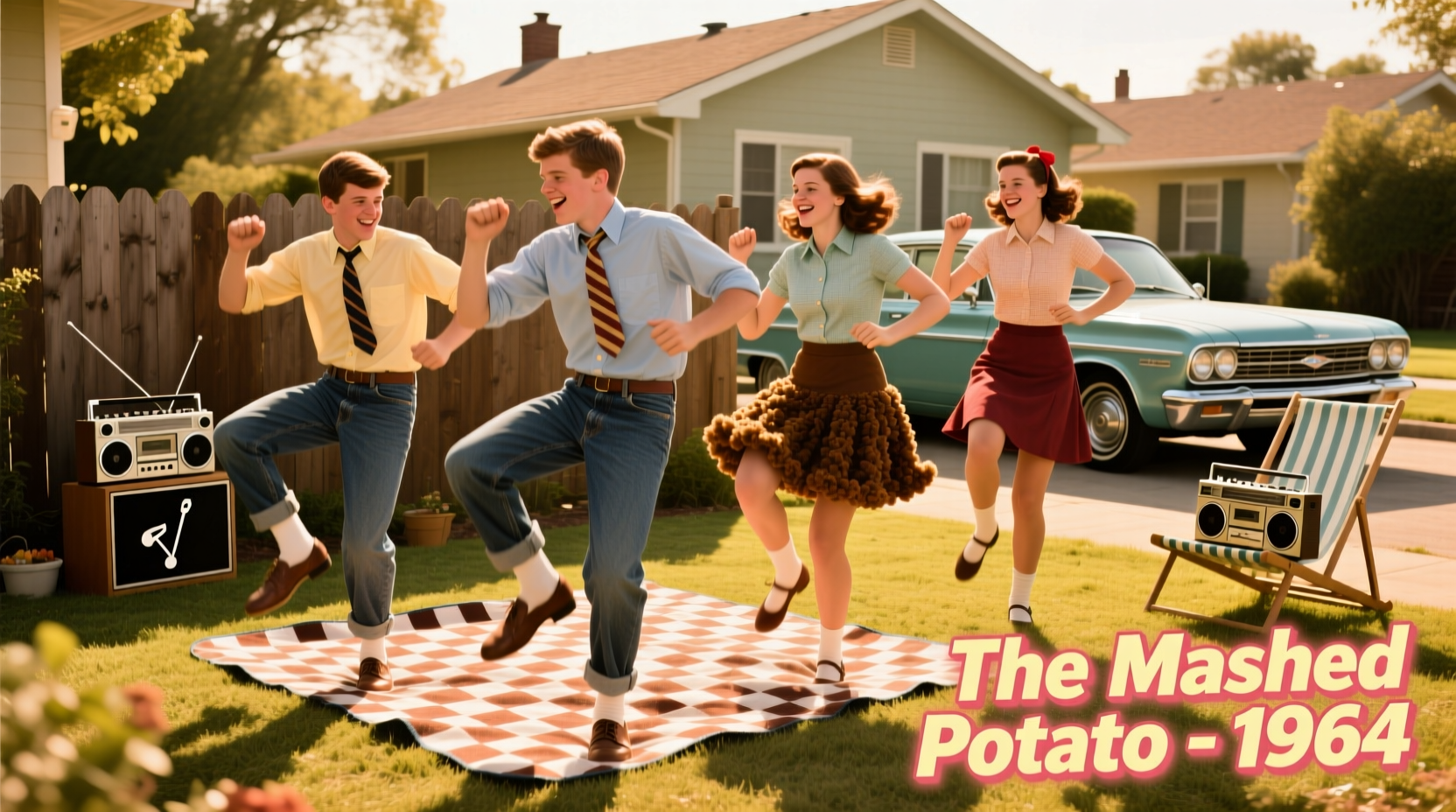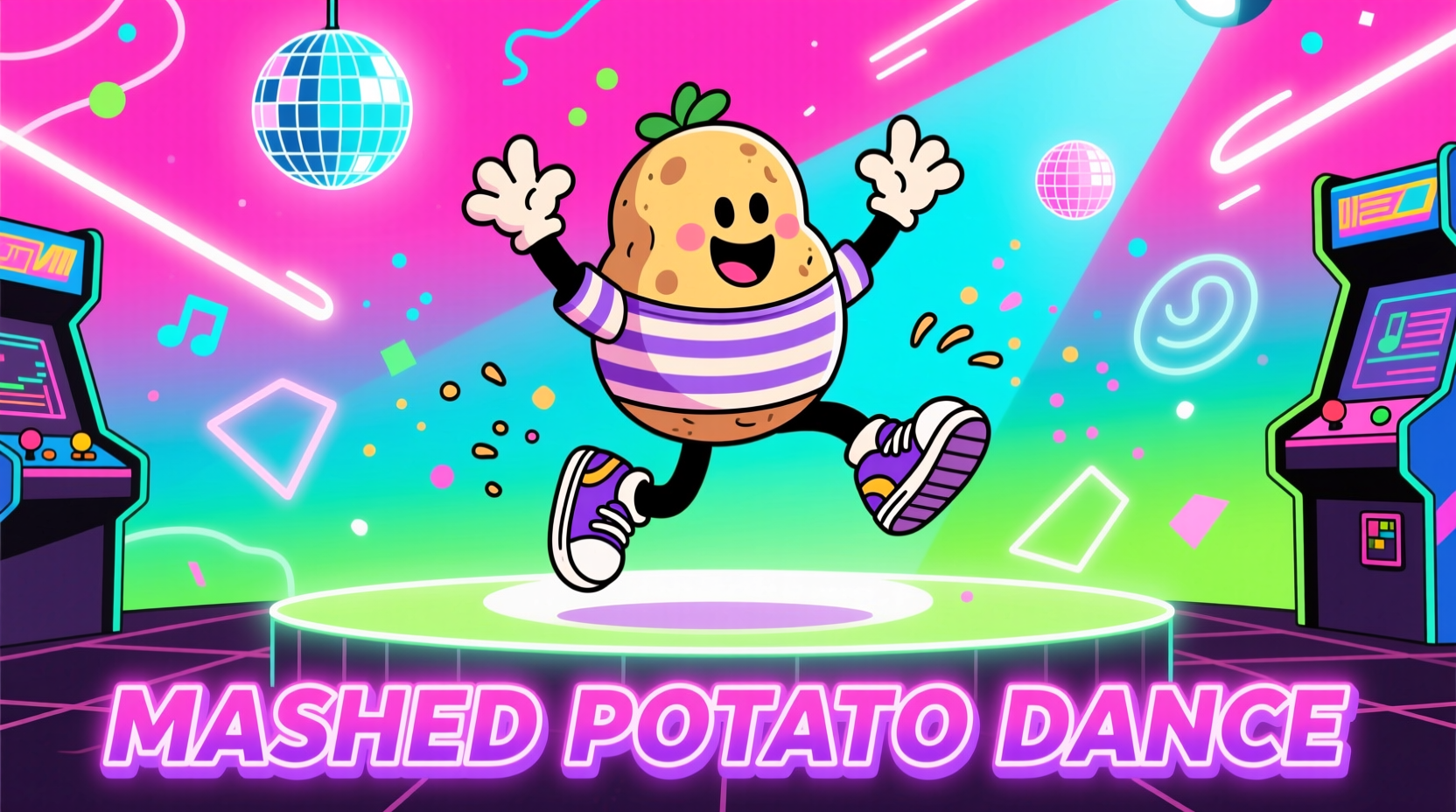What Exactly Is the Mashed Potato Dance and Why Did It Capture America?
If you've ever wondered about the mashed potato dance meaning or why this peculiar movement became a national sensation, you're not alone. This iconic 1960s dance move wasn't just a random fad—it represented a cultural shift in American social dancing that broke away from formal partner dances toward individual expression. Unlike the twist which required no partner, the mashed potato could be performed solo or in groups, making it accessible to everyone from teenagers to adults.
Step-by-Step Guide to Mastering the Classic Mashed Potato Move
Learning how to do the mashed potato dance properly requires understanding its distinctive footwork. Follow these steps to get the authentic 1960s mashed potato dance technique:
- Stand with feet shoulder-width apart, knees slightly bent (this is crucial for the authentic mashed potato stance)
- Shift your weight to your left foot while lifting your right foot slightly off the ground
- Rotate your right foot in a small clockwise circle, keeping your heel close to the floor
- Repeat the circular motion with your left foot in a counterclockwise direction
- Maintain a slight bounce in your knees throughout the movement
- Keep your upper body relatively still while your feet create the “mashing” motion
- Sync your movements to the beat of classic mashed potato songs like “Mashed Potato Time”
Many beginners make the mistake of lifting their feet too high—the authentic mashed potato dance involves keeping your feet close to the floor, almost as if you're actually mashing potatoes beneath your shoes. Practice slowly at first, then increase your speed as you become comfortable with the circular foot motion.

From Harlem to Mainstream: The Cultural Journey of the Mashed Potato
The mashed potato dance history reveals an important pattern in American cultural development. While many believe it originated with Dee Dee Sharp's 1962 hit, the dance actually emerged from African American communities in the late 1950s. According to the Smithsonian National Museum of American History, similar footwork appeared in various regional dances before being popularized nationally.
| Timeline Stage | Key Development | Cultural Significance |
|---|---|---|
| Late 1950s | Emergence in African American communities, particularly in Baltimore and Philadelphia | Part of the broader development of social dances that emphasized individual expression over formal partner work |
| Early 1960s | Adoption by mainstream audiences through television appearances | One of the first dances to cross racial barriers during the early civil rights era |
| 1962 | Dee Dee Sharp releases “Mashed Potato Time,” reaching #2 on Billboard charts | Created a national dance craze that appeared in schools, parties, and social gatherings across America |
| Mid-1960s | Evolution into more complex variations like the “freddie” and “waterboy” | Demonstrated how dance crazes often build upon previous movements in American social dance history |
When and Where the Mashed Potato Dance Was Appropriate
Understanding the context boundaries of the mashed potato dance helps explain both its rapid popularity and relatively quick decline. Unlike some dance crazes that faced moral panic, the mashed potato was generally considered acceptable in most social settings of the early 1960s:
- School dances: One of the few dances permitted at many high school events due to its non-contact nature
- Television appearances: Frequently featured on shows like “American Bandstand” without controversy
- Family gatherings: Considered appropriate for all ages, unlike some more suggestive dances of the era
- Limitation: By 1964, it was already considered “passé” as newer dances like the twist variations took over
This social acceptability contributed significantly to the mashed potato dance widespread adoption. According to research from the Library of Congress's American Folklife Center, dances that could be performed in school settings had dramatically higher adoption rates among teenagers, who were the primary drivers of dance crazes during this period.
Why the Mashed Potato Dance Matters in Dance History
The mashed potato dance significance extends beyond being just a nostalgic party trick. This dance represents a critical transition point in American social dancing:
- It helped shift dance culture from formal partner work to individual expression
- Demonstrated how African American dance innovations entered mainstream culture
- Laid groundwork for future solo dances like the bump, the bus stop, and even modern viral dances
- Highlighted the growing influence of rhythm and blues on mainstream American culture
Modern dance historians recognize the mashed potato as part of what scholar Katrina Hazzard-Donald calls the “second generation” of African American social dances that gained mainstream popularity. These dances differed from earlier forms by emphasizing individual interpretation rather than strict step patterns, a philosophy that continues to influence social dancing today.
Keeping the Tradition Alive: Where to See and Learn the Mashed Potato Today
While you won't find the mashed potato dance dominating TikTok like contemporary dances, it remains a beloved part of retro dance culture. Here's where enthusiasts keep this classic move alive:
- Retro dance events: Many 1950s/60s themed parties include mashed potato dance instruction
- Dance history classes: Universities with dance programs often cover this as part of American social dance history
- Senior centers: Popular activity for older adults reminiscing about their youth
- YouTube tutorials: Search for “how to do the original mashed potato dance” for authentic demonstrations
When attending a retro dance event, don't be surprised if the DJ mixes in Dee Dee Sharp's classic track. Knowing the proper mashed potato dance steps will help you join in the fun and connect with a significant moment in American cultural history.
Frequently Asked Questions About the Mashed Potato Dance
Who invented the mashed potato dance?
The mashed potato dance wasn't invented by a single person but emerged from African American communities in the late 1950s, particularly in Baltimore and Philadelphia. While Dee Dee Sharp popularized it with her 1962 hit “Mashed Potato Time,” the dance existed in various forms before her song brought it to national attention.
What song is most associated with the mashed potato dance?
Dee Dee Sharp's “Mashed Potato Time” (1962) is the song most famously associated with the dance, reaching #2 on the Billboard Hot 100. Other popular mashed potato dance songs include “The Stroll” by The Diamonds and “Mashed Potatoes” by James Brown, though Sharp's track remains the definitive anthem for the dance craze.
How is the mashed potato dance different from the twist?
While both were 1960s dance crazes, the mashed potato involves circular foot movements while keeping knees bent and feet close to the floor, mimicking mashing potatoes. The twist focuses on rotating the hips while standing more upright with feet planted. The mashed potato requires more precise footwork, while the twist emphasizes hip movement. Both dances allowed for solo performance, breaking from traditional partner dancing.
Is the mashed potato dance still performed today?
Yes, the mashed potato dance is still performed at retro dance events, 1950s/60s themed parties, and by dance history enthusiasts. Senior centers often feature it as a nostalgic activity, and some vintage dance classes teach it as part of American social dance history. While not a mainstream dance today, it remains a beloved classic that connects modern dancers with mid-20th century American culture.











 浙公网安备
33010002000092号
浙公网安备
33010002000092号 浙B2-20120091-4
浙B2-20120091-4